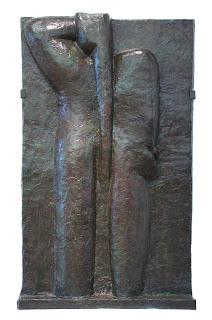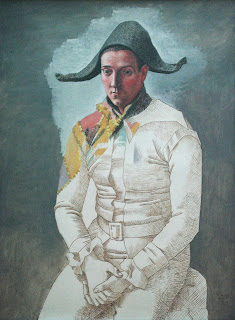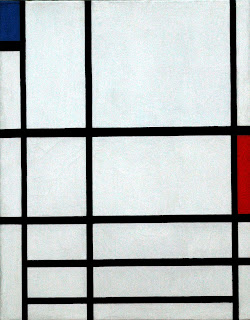Today was to be a huge one, going to the Pompidou Centre, and if there was time, to the Musée Picasso.
The Pompidou Centre is the mecca for aficianados of modern art. Its policy is to provide a platform to expose the best (and perhaps the worst) of latter-day artists, from the post-impressionists onwards. The building itself is an example of just this, horrifying the Parisians when it was first put up, but now just a part of the Parisian cityscape. They were concerned that all the plumbing seemed to be on the outside of the building — but, strangely, it works as a modern sculpture.
As you approach the building, if you come from the right direction, you come through a small square. On one side of it is wall art and graffiti, which is as much a part of the Pompidou Centre's exhibitions as anything else. And in the square is a largs pond in shich there are numerous water mobiles and statues. Some are quite bizarre - it somewhat takes you aback when confronted by a large multicoloured female form with water spirting from the nipples! But this is as much an exploration of French modern design and the French sense of humour!
With our Museums Pass, we were able to circumvent the queue that was starting to snake across the forecourt.
When you get inside, you go up the escalators in the clear plastic tubes on the front of the building, and get up to the exhibition spaces. They had an exhibition on the top floor of an artist we'd never heard of, and who didn't inspire us at all, so we gave that a miss. We went down to the next floor, the main permanent exhibition — although, because of their exhibition policy, even this is a bit of a changeable feast. But the major early artists of the 20th century are well represented here.
Again, we will let the photos speak for themselves — although there are links here to articles on each of the artists.
The view from the 'balcony' of this floor looks over old Paris, and down into the courtyard where a solitary flamenco busker looked very lonely.
We then went down to the next floor, which has the most recent works. To be perfectly honest, a lot of this stuff left us somewhat unimpressed. One 2012 work in particular made us ask, "What is art?" — at least the 'Artist', Fernanda Gomes, didn't have the cheek to give it a title! The attendant sitting in that room seemed to have the same opinion of the 'work' as we did.
On the other hand, there was another interpretation of Degas' Le Déjeuner sur l'herbe (Alain Jacquet, 1964) that was intriguing.
Because we didn't feel we wanted to spend much time with much of this modern stuff, we decided to make our way round to the Musée Picasso. On the way we passed a pistacherie (a shop that specialises in pistachio nut products!), and a really great group of buskers playing good cool jazz!
Now, you mightn't like Picasso as a person, but as an artist he really stretched the boundaries. We were a little surprised, as we knew his style had chanced dramatically over the years, but we weren't aware that he never really dropped any of his techniques — there are works from the 1950s that you would swear he had painted in the 1910s.
Picasso's art is usually divided into periods ...
- Blue Period (1903-5), where the paintings are predominantly blue in tone, and the subject material is 'blue' or melancholy — and then he broke from teese subjects with Harlequin and circus themes.
- Rose Period (1905-6), the paintings with a pink or rose tone, and the subject material more romantic.
- Then we get to the experimental period (1907-25), where he develops cubism and other more geometric styles, typified by distortions of the natural forms. The colours here thend to be dull.
- Neo-Classicism (1920-30), with massive Grecian-style women.
- Surrealism (1926 onwards), with subjects that have a dreamlike nature.
There are other styles that are sometimes mentioned — stained glass, expressionism, an African period, and so on — it all just underlines that Picasso was continually experimenting. Many people love some of his works, and dislike others. This is almost inevitable when an artist works in such a diverse way.
One thing that has always impressed us is his sense of line. He could apply a few strokes of the pen or the brush to the paper or canvas and evoke the essence of what he wanted to convey. And in this museum, we were able to see his though processes at work — he was always trying to simplify, to get a more direct expression of the 'essence' of his subject. This is nowhere more obvious than in a series of etchings 'Le Taureau' done between 12 December 1945 and 5 January 1946 — each subsequent essay is a simplification on what has gone before, but in no case are you in any doubt that the subject is a bull.
He has been accused of being misogynistic in the way he paints his women. This may be true — he had a long relationship with the Russian ballerina Olga Khokhlova — his earliest paintings or drawings of her, around 1918, are quite sympathetic, but when you look at one from 1929, you get a shock. But is this just his experiments in style taking over? — Although it is on record that this was painted during a period when his relationship with Olga was strained, to say the least!
Picasso was a strong campaigner for world peace, usually using the theme of the dove (La Paloma) in works on this topic (although his Guernica that we saw in Madrid is a far more stark representation of the horrors of war).
Fully sated, leg weary, we made our way back home to the van. On the way, we noticed art work in a shop window that was as good as much of we had seen today. We also admired some virginia creeper just on the turn for autumn, and we passed a carousel in the street — they tend to pop up virtually anywhere over here!
Distance driven — today, nil; to date, 29,782 miles ( 47,930 km )
























































































































Has it ever occurred to anyone to wonder if Picasso was generally stoned or mad?
ReplyDeleteGreat innovator but once again pure merde! Nothing for me here thanks, but glad you seemed to enjoy him. Love from the art illiterate, Cathy.